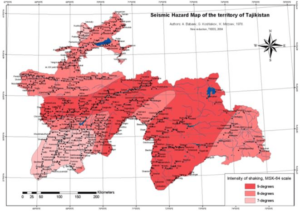Introduction:
On Monday evening, Tajikistan experienced a seismic event that sent ripples through the region. The National Center for Seismology (NCS) reported a magnitude 4.9 earthquake, adding to the geological activity that continues to shape the landscape of this Central Asian country.
Understanding the Magnitude:
The Richter scale is a crucial tool in measuring earthquakes, providing insights into the intensity of seismic events. A magnitude 4.9 earthquake signifies a moderate event, capable of causing damage to poorly constructed buildings but unlikely to result in widespread destruction. Despite its moderate classification, the impact can vary depending on factors such as depth and local geological conditions.
Tajikistan’s Geological Landscape:
To comprehend the significance of this earthquake, it’s essential to delve into Tajikistan’s geological makeup. Nestled in the heart of the Pamir Mountains, the country is part of the seismically active zone of the Alpine-Himalayan tectonic belt. The collision of the Indian and Eurasian plates in this region makes earthquakes a recurring phenomenon.
Timing and Depth of the Tremor:
The earthquake struck at 5:46 pm, a time when communities were engaged in their evening routines. The depth of 194 km is a notable aspect, as it influences the impact felt on the Earth’s surface. Deeper earthquakes often result in less intense shaking at ground level, mitigating potential damage.

Impact on Communities:
As the tremors reverberated across Tajikistan, communities experienced the unsettling force of nature. While a magnitude 4.9 earthquake is not considered major, the effects on structures and residents can vary. Vulnerable buildings may sustain damage, and the psychological impact on the local population cannot be overlooked.
Seismic Preparedness:
In regions prone to earthquakes, preparedness is paramount. Tajikistan, like many other seismically active areas, has implemented measures to enhance resilience. Building codes, early warning systems, and public awareness campaigns play a crucial role in minimizing the impact of earthquakes on both infrastructure and human lives.

Global Seismic Trends:
The Tajikistan earthquake is part of a larger global pattern of seismic activity. Understanding these trends allows scientists to refine earthquake prediction models and develop strategies for mitigating the impact of future events. The interconnected nature of Earth’s tectonic plates underscores the importance of international collaboration in seismic research.
Lessons Learned:
Each earthquake provides an opportunity to learn and improve our understanding of geological processes. The data collected from the Tajikistan earthquake will contribute to the global knowledge base, fostering advancements in earthquake science and preparedness.
Conclusion:
As Tajikistan grapples with the aftermath of the magnitude 4.9 earthquake, it serves as a reminder of the dynamic forces shaping our planet. While this event may not have caused widespread devastation, it highlights the ongoing need for vigilance, research, and preparedness in regions susceptible to seismic activity. The resilience of communities and the continuous efforts of scientists worldwide contribute to our collective ability to navigate the unpredictable nature of Earth’s geology.










